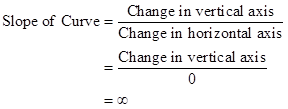
(a) If the price of movies increases, fewer consumers go to see movies.
(b) More experienced workers typically have higher incomes than less experienced workers.
(c) Whatever is the temperature outside, people consume the same number of hot dogs per day.
(d) Consumers buy more frozen yogurt when the price of ice cream goes up.
(e) Research finds no relationship between the number of diet books purchased and the number of pounds lost by the average dieter.
(f) Regardless of its price, people buy the same quantity of salt.
Concept Introduction
The slope of a line:
The slope of a line represents the change in the value of y-axis per unit value on the x-axis. The slope of a line is a measure of the steepness of the line.
Explanation of Solution
(a) If the price of movies increases, fewer consumers go to see movies.
- Panel (a) matches the given statements because as the price of the movies will increase, the number of fans going to movies will decrease.
- The variable ‘price of movies’ shall appear on the vertical axis and the variable ‘number of fans’ will appear on the horizontal axis.
- As the variable on the vertical axis increases, the variable on the horizontal axis will decrease. Thus, there is a negative relationship between the two variables indicating the slope is negative. The curve is Concave or decreasing.
Conclusion:
Thus, the slope is negative.
(b) More experienced workers typically have higher incomes than less experienced workers.
- Panel (c) matches the given statements because as the experience of a worker increases, the income will also increase.
- The variable ‘experience of workers’ shall appear on the vertical axis and the variable ‘income of workers’ will appear on the horizontal axis.
- As the variable on the vertical axis increases, the variable on the horizontal axis will also increase. Thus, there is a positive relationship between the two variables indicating that the slope is positive. It is a convex curve or increasing.
Conclusion:
Thus, the slope is positive.
(c) Whatever is the temperature outside, people consume the same number of hot dogs per day.
- Panel (d) matches the given statements because whatever is the outside temperature, the hot dog consumption remains the same.
- The variable ‘temperature’ shall appear on the horizontal axis and the variable ‘consumption of hot dogs’ shall appear on the vertical axis.
- Even if the variable on the horizontal axis increases, the variable on the vertical axis will remain the same. Thus, there is no relationship between the two variables indicating that the slope is zero.
Conclusion:
Thus, the slope is zero.
(d) Consumers buy more frozen yogurt when the price of ice cream goes up.
- Panel (c) matches the given statement because as the price of ice cream increases, the sale of frozen yogurt also increases.
- The variable ‘price of ice cream’ shall appear on the vertical axis and the variable ‘sale of frozen yogurt’ will appear on the horizontal axis.
- As the variable on the vertical axis increases, the variable on the horizontal axis will also increase. Thus, there is a positive relationship between the two variables indicating that the slope is positive.
Conclusion:
Thus, the slope is positive.
(e) Research finds no relationship between the number of diet books purchased and the number of pounds lost by the average dieter.
- Panel (d) matches the given statements because whatever is the number of diet books purchased, the number of pounds lost by the average dieter does not change.
- The variable ‘number of diet books purchased’ shall appear on the horizontal axis and the variable ‘number of pounds lost by average dieter’ shall appear on the vertical axis.
- Even if the variable on the horizontal axis increases, the variable on the vertical axis will remain unchanged. Thus, there is no relationship between the two variables indicating that the slope is zero.
Conclusion:
Thus, the slope is zero.
(f) Regardless of its price, people buy the same quantity of salt.
- Panel (b) matches the given statements because whatever is the price of salt, the quantity of salt purchased remains the same.
- The variable ‘quantity of salt’ shall appear on the horizontal axis and the variable ‘price of salt’ shall appear on the vertical axis.
- Even if the variable on the vertical axis increases, the variable on the horizontal axis will remain unchanged. Thus, the slope shall be:

Conclusion:
Thus, the slope is infinity.
Want to see more full solutions like this?
Chapter 2A Solutions
Essentials of Economics
- Not use ai pleasearrow_forwardThere are many different ways that governments collect taxes. In Zambia alone there are income taxes, taxes on copper and other mining royalties, taxes on property and financial transactions among others. One common tax is sales tax. Sales taxes are collected by the retailer when the final sale in the supply chain occurs via a sale to the end customer. In some parts of the world, however, rather than a sales tax, there is a Value Added Tax (VAT). In a VAT system taxes are collected by all sellers in each stage of the supply chain. Suppliers, Manufacturers, Distributors, and Retailers all collect the VAT on applicable sales and consumers pay the VAT on their purchases. The Zambian government in recent years has heavily debated the merits of which system is better a national sales tax on end purchase transactions or a VAT which collects taxes at each stage. For the purposes of this research paper, debate whether Zambia should have a national sales tax system or a VAT system. Which…arrow_forwardThe U.S. Census Bureau conducts annual surveys to obtain information on the percentage of the voting-age population that is registered to vote. Suppose that 679 employed persons and 690 unemployed persons are independently and randomly selected, and that 429 of the employed persons and 369 of the unemployed persons have registered to vote. Can we conclude that the percentage of employed workers (P1), who have registered to vote, exceeds the percentage of unemployed workers (P2), who have registered to vote? Use a significance level of α = 0.05 for the test. Step 5 of 6: Determine the decision rule for rejecting the null hypothesis Ho. Round the numerical portion of your answer to three decimal places.arrow_forward
- I need help with the one that says Model Legibility. Would this be the zero Conditional mean?arrow_forwardConsider a standard Hotelling model of competition with quadratic transportation costs. The consumers are located uniformly along a segment of unit length. There are two firms, A and B, located at the opposite ends of the segment. Each firm has constant marginal costs 2. Each consumer buys at most one unit of product and gets utility 20. Each consumer incurs travel cost of 4 times the square of traveled distance. Find equilibrium price and profit of firm A when firms set a unform price for the entire Hotelling segment. Suppose now that firms can price discriminate between consumers located in the interval 悯 (interval 1) and those located in the interval 瞓 (interval 2). Find equilibrium prices of firm A and B on the interval 1. Answer: equilibrium uniform price of firm A = profit of firm A under uniform pricing = equilibrium price of firm A on interval 1 = equilibrium price of firm B on interval 1 = ✓arrow_forwardDon't give AI generated solution Give all answers Please send me the graph for part farrow_forward

 Principles of Economics (12th Edition)EconomicsISBN:9780134078779Author:Karl E. Case, Ray C. Fair, Sharon E. OsterPublisher:PEARSON
Principles of Economics (12th Edition)EconomicsISBN:9780134078779Author:Karl E. Case, Ray C. Fair, Sharon E. OsterPublisher:PEARSON Engineering Economy (17th Edition)EconomicsISBN:9780134870069Author:William G. Sullivan, Elin M. Wicks, C. Patrick KoellingPublisher:PEARSON
Engineering Economy (17th Edition)EconomicsISBN:9780134870069Author:William G. Sullivan, Elin M. Wicks, C. Patrick KoellingPublisher:PEARSON Principles of Economics (MindTap Course List)EconomicsISBN:9781305585126Author:N. Gregory MankiwPublisher:Cengage Learning
Principles of Economics (MindTap Course List)EconomicsISBN:9781305585126Author:N. Gregory MankiwPublisher:Cengage Learning Managerial Economics: A Problem Solving ApproachEconomicsISBN:9781337106665Author:Luke M. Froeb, Brian T. McCann, Michael R. Ward, Mike ShorPublisher:Cengage Learning
Managerial Economics: A Problem Solving ApproachEconomicsISBN:9781337106665Author:Luke M. Froeb, Brian T. McCann, Michael R. Ward, Mike ShorPublisher:Cengage Learning Managerial Economics & Business Strategy (Mcgraw-...EconomicsISBN:9781259290619Author:Michael Baye, Jeff PrincePublisher:McGraw-Hill Education
Managerial Economics & Business Strategy (Mcgraw-...EconomicsISBN:9781259290619Author:Michael Baye, Jeff PrincePublisher:McGraw-Hill Education





